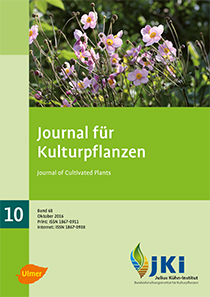Light red and dark red as well as far red light in the cultivation of tomato
Keywords:
Tomato, light red, dark red, lycopen, β-carotin, antioxidants, coloured foilsAbstract
A lot of research has been done on the productiveness of tomato. An increased red part in the light spectrum was confirmed as yield-supporting. At the same time there are some indications that the red light influences the synthesis of antioxidants in tomato positively. However, it was not described in what way the plant development was influenced by the narrow wavelength area of 700 ± 30 nm (dark red). Some investigations proved that this spectrum part functions as indicator for deteriorating conditions for the plants and leads in some species to an accelerated development. In its own investigations the IASP wanted to create light conditions that can affect both parameters positively: antioxidant contents and yield. Moreover, the increased dark red part of the light was supposed to act as slight stress and thereby accelerate the plant development.
The dwarf tomatoes ‘Micro Tom‘ were exposed to modified light spectra by means of foils and LEDs in specially constructed boxes. The light regimes in the boxes differed by the red-blue ratio from maximum 6,6:1 to minimally 1.7:1. The dark red part varied from approx. 14% to approx. 9% of the photon flux density. In the first trial the plants were exposed to the changed light spectra for 3 weeks in three different development phases (4–8 real leaves, beginning of flowering and beginning fruit development). Afterwards they were cultivated under the usual greenhouse illumination. In the parallel trial the plants were kept in the boxes with the modified light during the whole cultivation time.
A distinct reaction of the tomato plants from the youngest development phase on the 3-week cultivation under more red and dark red light was observed. After an initial delay in flowering, the plants finally produced significantly more inflorescences and fruits. The effect of these light regimes showed several weeks later and had also been accompanied by an increased concentration of antioxidants.
By means of coloured foils not only the light spectrum was altered but also the photon flux density impaired. This acted as unavoidable additional parameter and reduced the explanatory power of the comparison of the plant development under foils and under normal greenhouse lighting. Nevertheless, the test results are interesting for real fruit production and should be specified under practical conditions of greenhouses or Spanish tunnels.
DOI: 10.5073/JfK.2016.10.02, https://doi.org/10.5073/JfK.2016.10.02
Downloads
Published
Issue
Section
License
The content of the journal is licensed under the Creative Commons Attribution 4.0 License. Any user is free to share and adapt (remix, transform, build upon) the content as long as the original publication is attributed (authors, title, year, journal, issue, pages).
The copyright of the published work remains with the authors. The authors grant the Journal of Cultivated Plants, the Julius Kühn-Institut and the OpenAgrar repository the non-exclusive right to distribute and exploit the work.







